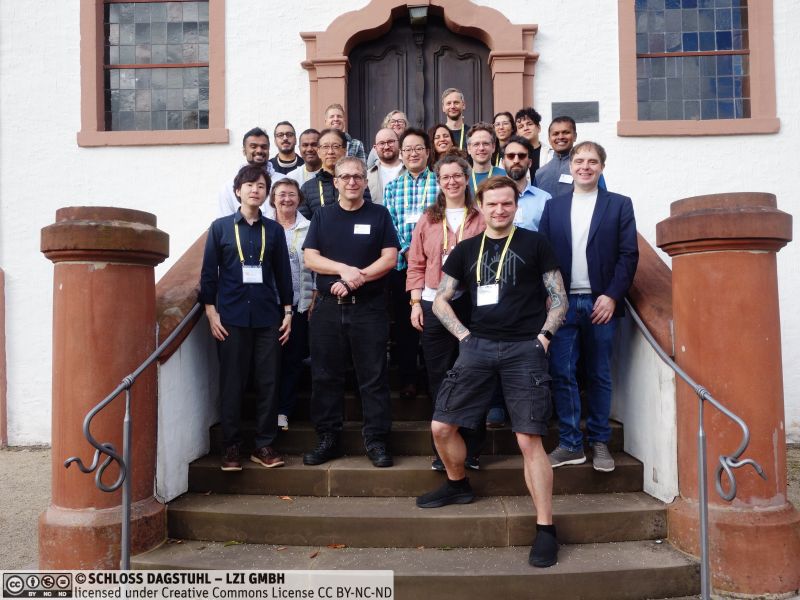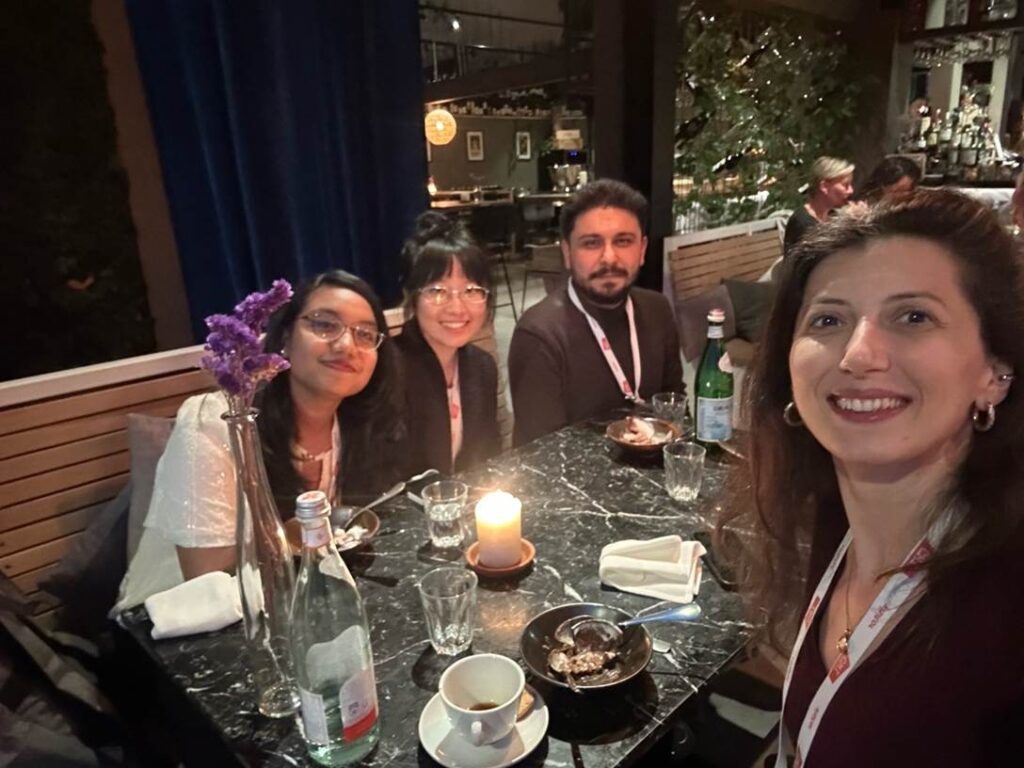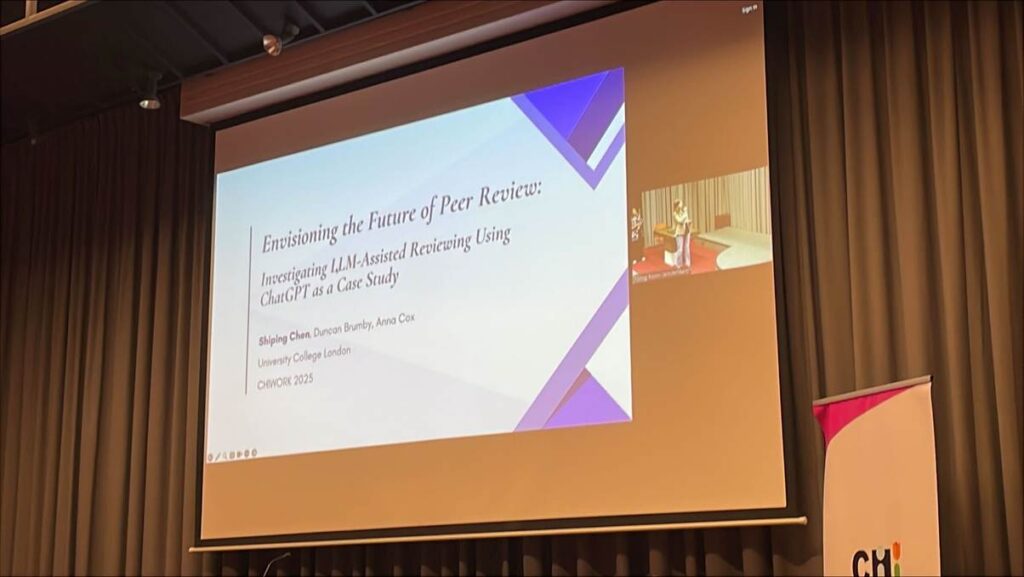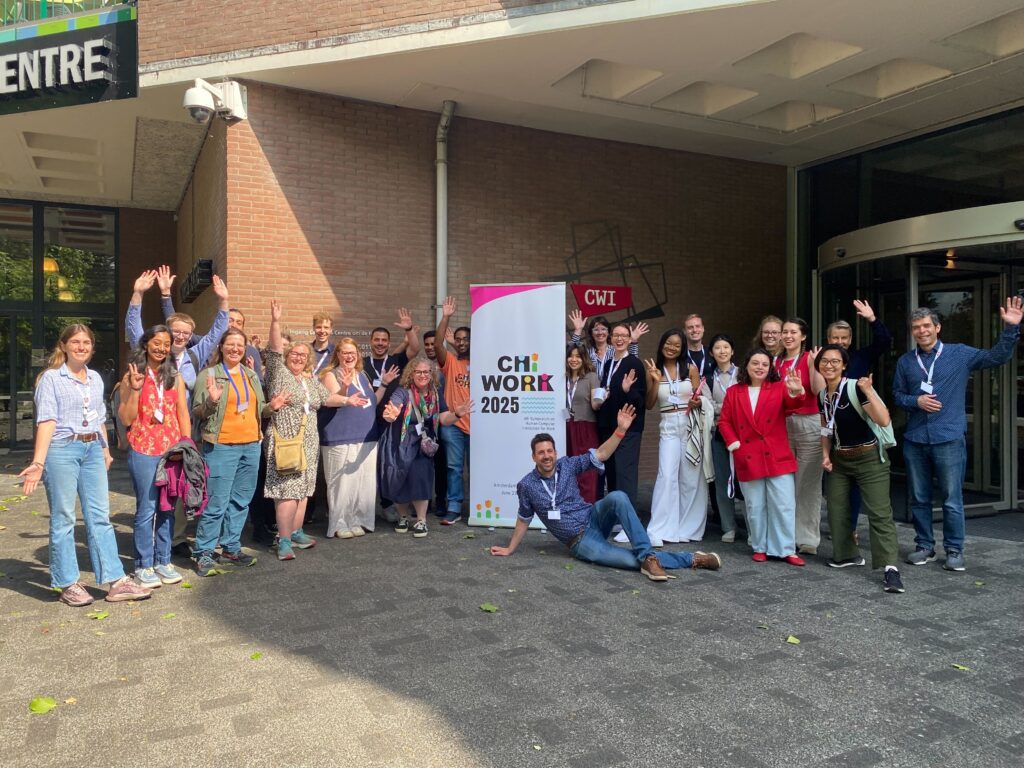Home » Articles posted by drannalcox
Author Archives: drannalcox
Cognitive Sensing for Human–Computer Interaction
Just back from a Dagstuhl seminar on Cognitive Sensing for Human–Computer Interaction — an excellent few days of discussion about how sensing technologies, interaction, human augmentation, and ethics.

This seminar aimed to bring together specialists and experts in HCI, machine perception, psychology, neuroscience, and AI to investigate the possibilities of digitally sensing, interacting, and enhancing user cognition. We considered the following research questions:
- Robust Interaction: How do we design robust cognitive interaction in and for everyday settings?
- Cognitive Augmentation: How can we augment and interact with user cognition while avoiding replacing innate skills with technology?
- Inclusivity, Diversity, and Reproducibility: How do we ensure inclusivity and diversity during cognitive interaction while accounting for individual cognitive diversity and improving the reproducibility of research results?
CHIPLAY 2025 lasting impact award
Our 2015 CHI PLAY paper on removing HUDs and player involvement just won the CHIPLAY 2025 Lasting Impact Award. The award honours one influential paper published at CHI PLAY that has significantly impacted the CHI PLAY community and has shown sustained influence.
Thanks especially to Jo Iacovides, who gave the acceptance talk at the conference in Pittsburgh this week and to the members of the Lasting Impact Award Committee for this honour.
Jo Iacovides, Anna Cox, Richie Kennedy, Paul Cairns, and Charlene Jennett. 2015. Removing the HUD: The Impact of Non-Diegetic Game Elements and Expertise on Player Involvement. In Proceedings of the 2015 Annual Symposium on Computer-Human Interaction in Play (CHI PLAY ’15). Association for Computing Machinery, New York, NY, USA, 13–22. https://dl.acm.org/doi/10.1145/2793107.2793120
New Starts at Home, New Focus at Work – Autumn 2025
This time of year always brings a sense of new beginnings—buying school uniforms at home and preparing for the arrival of new students at work. This autumn adds another milestone: getting my eldest ready to start their new adventure at university.
As they head off into this new chapter of their life, I’ve been reflecting on what I’ve learned from my sabbatical and what the coming academic year might hold for me. My diary is already filling up with interesting things, and I’m excited for the months ahead. But I also know I’ll face the familiar challenge of not overloading myself by saying “yes” to too many opportunities.
Recently, I had the chance to talk with Geraldine Fitzpatrick about how I’m trying to stay in control of my commitments by:
a) working out how much of my time is already spoken for, and how much is still available to promise to others, and
b) keeping a very short list of main goals for the year, giving each one its own season to be my priority.
You can catch our conversation on the latest episode of Geraldine’s podcast. And if you’d like to try the same exercise, check out the approach described by Loleen Berdahl for calculating your commitments and your remaining time to promise.
What if a shorter work week could make us healthier, happier, and more productive?
I had a fun conversation with Professor Rochelle Burgess & Dr Xand van Tulleken on their podcast about the public health case for a four-day work week.
🚨 New episode of Public Health Disrupted out now!
Is it time to rethink the 9 to 5?
In this episode, we explore the public health case for a four-day work week.
Joe Ryle, from the 4 Day Week Foundation, shares compelling new data from pilot studies showing:
✅ 62% reduction in burnout
✅ 41% improvement in mental health
Joined by UCL’s Professor Anna Cox, they unpack how flexible working, digital technologies, and cultural shifts could reshape our relationship with work for the better.
🎧 Listen on Apple: https://lnkd.in/g-RNaezH
🎧 Listen on Spotify: https://lnkd.in/giQF4jRT
Public Health Disrupted is a podcast by UCL Health of the Public.
Paving the Way for AI that Supports Flourishing at Work — CHIWORK’25 Workshop
by Sowmya Somanath from University of Victoria | Reblogged from https://medium.com/@labvixi/paving-the-way-for-ai-that-supports-flourishing-at-work-chiwork25-workshop-314f9c1fadcf
| We recently ran a workshop at CHIWORK together with Sowmya Somanath and others. Sowmya wrote a blogpost for the VIXI lab blog which we are reblogging here. |
We recently conducted a workshop on the topic of AI and ways it can support flourishing at work [1] during the CHIWORK’25 conference. During the workshop we discussed questions such as: What does flourishing mean in the context of work? How might AI help? Is it currently helping? Why not? We had a fantastic group of attendees who shared many great ideas and thoughts on these topics. This blog post briefly summarizes our discussions.
Our workshop was attended by 27 participants and included students, professors, and industry researchers. Participants had many different research interests. Related to work, participants were interested in domains such as human creativity, and craft work, and processes such as how care is provided in work contexts, and how technologies and work practices influence each other. Regarding AI, participants thought about how AI can augment human intelligence, human-AI collaboration, and AI’s impact on human experiences. Lastly, participants conceived flourishing in different ways, including longer-term happiness and health, engagement, protecting labour, resilience, protecting against burnout, and empowering people to prioritize things that matter to them.
A photo from the workshop. Participants: Regan Mandryk, Sabrina Burtscher, Kevin Chow, Michael Muller, Juliance Busboom, Simone Ooms, Marta Cecchinato, Raza Mohsin Chaudhry, Kuntal Ghosh, Marios Constantinides, Sarah Frampton, Marcia Ash, (Nancy) Qing Xia, Charles Chiang, Soyun Lee, Alina Lushnikova, Virpi Roto, Alessandro Fornaroli, Minha Lee, Gulbahar Coskun, Ekaterina Uetova, Zoe Mitchell, Samiksha Singh, Janne Lindqvist, Vera Khovanskaya, Chaeyeon, Yifei Gao. Workshop organizers: Yoana Ahmetoglu, Carine Lallemand, Erin T. Solovey, Duncan P. Brumby, Anna L. Cox, and Sowmya Somanath.
During the workshop, we engaged in three main activities — 1) identifying a research problem/opportunity that highlights challenges for flourishing at work, 2) a quick analysis of AI tools and how they can(not) support flourishing at work, and 3) reflection on what we might stop, start, and continue doing in HCI research to facilitate flourishing at work in the era of AI tools.
Related to research challenges, a common theme that was echoed often related to flourishing by bringing back the focus to things that make us human. These included aspects such as enabling identity formation, wanting control and autonomy, and thinking about our contributions not in terms of numbers, but in terms of the people and experiences that make a project successful. Within such a framing, AI tools were considered to be like a “double-edged sword” — wherein they both helped people (e.g., sometimes people don’t always know what might help them flourish and tools can facilitate reflection) and at other times came in their way of flourishing (e.g., over-reliance, may push normativity, and built in politics). The double-edged nature of AI however is not an easy problem to solve given its generative nature and its rapid integration into workplaces. Our participants shared many thoughts on what we might do next. For example, some argued that we should stop equating productivity to flourishing, while others suggested that perhaps we should stop thinking in terms of utopia and dystopia, and think about the scenarios that exist in between these extremes. Suggestions to move forward included thinking back to human relationships with non-human intelligences and drawing inspiration from those, focusing on understanding the meaning behind AI tool use, and going back to the basics of understanding humans and their contexts much more deeply before we focus on tools.
For me this was a very rich workshop experience that generated a lot of food for thought! The wide ranging responses to the types of work, AI-related questions, and what flourishing means highlights the exciting possibilities for future research directions to which HCI researchers can contribute! Work, while not the only part of our lives, is integral and an important aspect of many people’s lives and so I believe these discussions are important, and we must have them now while so many people are thinking about AI tools. If these topics interest you, please reach out — collaborations and research partnerships I think are key to advancing these topics in a meaningful and reflective way. Let us continue the conversation on how we can flourish* — at work or outside, and in the era of AI or not!
Reference:
[1] Yoana Ahmetoglu, Sowmya Somanath, Carine Lallemand, Erin T. Solovey, Duncan P. Brumby, and Anna L. Cox. “Paving the Way for AI that Supports Flourishing at Work.” In Adjunct Proceedings of the 4th Annual Symposium on Human-Computer Interaction for Work, pp. 1–3. 2025. https://dl.acm.org/doi/pdf/10.1145/3707640.3729208
Understanding Flourishing
* If you are interested or curious about Flourishing as a concept, here is a very brief primer we put together for the workshop as a starting point for discussions:
Note: this is not a comprehensive primer and there are several other papers and concepts that describe aspects of flourishing.
a. PERMA: Flourishing is a state we create when we tend to PERMA (Seligman, Martin EP. Flourish: A visionary new understanding of happiness and well-being. Simon and Schuster, 2011.)
PERMA maps to: Positive Emotions, Accomplishment, Engagement or flow, Relationships and Meaning
b. Positive Design: “flourishing is referred to as optimal human functioning and living to one’s full potential (Ryan & Deci, 2001)” and we can enable or simulate human flourishing when we design for the following three elements — virtue, pleasure, and personal significance. The emphasis can be on one of the elements but the design must not negatively impact the other two elements. (Desmet, Pieter MA, and Anna E. Pohlmeyer. “Positive design: An introduction to design for subjective well-being.” International journal of design 7.3 (2013).)
c. Positive Computing: The design and development of technology to support psychological wellbeing and human potential is referred to as “ positive computing” (Calvo, R. A., & Peters, D. (2014). Positive computing : technology for wellbeing and human potential. MIT Press.)
Below are four approaches to positive computing:

d. Designing for Happiness: Where should we begin design? Determinant factors or Strategies? (Somanath, Sowmya, Bahare Bakhtiari, and Regan L. Mandryk. “Design Fiction on Capturing, Amplifying, and Instilling Happiness in Work.” Proceedings of CHIWORK 2024.)
e. SDT theory: proposes that satisfaction of basic psychological needs — to experience competence, autonomy, and relatedness to others — can foster flourishing (Ryan, R. M., Ryan, W. S., Di Domenico, S. I., & Deci, E. L. (2019). The nature and the conditions of human autonomy and flourishing. The Oxford handbook of human motivation, 89.)

Questions questions
By Nancy Xia
This year at CHIWORK 2025, which took place in the beautiful city of Amsterdam, I challenged myself to ask questions to the speakers at the conference.
Initially, my motivations were entirely personal. I wanted to develop my own confidence in voicing my thoughts and reflections before an audience. In addition, many of the works presented were genuinely engaging, thought-provoking, and sparked my curiosity, and I found myself putting up my hand at papers I did not expect myself to ask questions for!
This year, I was most taken in by the studies which explored the ways in which technology facilitated, or disrupted, people’s abilities to present themselves in a professional environment. In Framing the (in)visible: Insights into Visibility Practices of Remote Workers by Mehrvarz et al., I found that knowledge workers may signal their availability through leaving tabs open. In Management Strategies for Reducing Boundary and Identity Clashes When Using Discord for Both Working and Gaming by Mandryk et al., I learnt that workers manage different levels of transparency and identity clashes between their professional and gaming persona on Discord. Finally, I was curious to note, in What Does Success Look Like? Catalyzing Meeting Intentionality with AI-Assisted Prospective Reflections by Scott et al., that users dislike making their intents to socialise explicit when reflecting on meeting intentionality. They have given me much fruit for thought in my own work, where I explore how people’s perceptions of specific software tools, such as spreadsheets or GenAI, can discourage people from engaging in important knowledge sharing activities. Because our work can be such an important part of our identity, so too does the technology that we use in this work become inextricably connected to how others see us.
But outside of this technology, in a very real conference, surrounded by very real people, every interaction exists in the moment. The digital bubbles of working from home give us time to think and prepare before every interaction. At the conference, there is no such luxury. Talks and slides and Pushbox microphones fly past, and there is always the chair, tapping their watch expectantly as you try to untangle your thoughts along with your tongue.
Yet when inspiration and curiosity sparks, the questions come easily. And with questions comes dialogue, venting, friendships, and learning. I quickly found that my favourite people at the conference were the ones who asked engaging questions themselves. Whether it was sitting in and listening in on a well-articulated discussion that I would never have quite known how to phrase for myself, or having someone ask me a well-thought out and challenging question in response to my own work, my
personal challenge slowly helped me to realise that it was the questions – asking and being asked – that led to the most fruitful moments of connections.
As a so-called ‘digital native’ who has never experienced a non-virtual work environment, I am used to digital workplaces that gives me too much time to curate and fuss over my social image. But my time at this conference has reminded me that it is often more rewarding to choose genuine curiosity over a polished appearance. I hope to stay curious, and keep working up the courage to ask questions throughout my life.
Me and Fairuz Nawer Meem – a fellow PhD student who I met at another conference and who came to CHIWORK this year thanks to my recommendation!
I’m super grateful to Anna for making this trip happen for all the A-team, and Yoana for all the organisation! Wonderful connections were made on the journey as well – especially over a devastatingly competitive game of Kemps/Kent!
First Academic Conference Experience
By Yifei Gao
CHIWORK 2025 was the very first academic conference I’ve attended since starting my PhD studies in February 2025. It was truly an eye-opening experience. I now have a much clearer understanding of what an academic conference involves, and I’ve learned a lot from participating.

First, I want to express my heartfelt thanks to Anna for taking us on this trip. Second to Yoana for organising the accommodation and train tickets. I had such an enjoyable time with everyone from our team.

Over the three-day conference, I took part in two workshops on Day 1:
- The Future of Human-Robot Synergy
- Paving the Way for AI that Supports Flourishing at Work
These workshops included group activities (such as designing a robot to help people work more efficiently in restaurants) and lively discussions with participants around the table. It was inspiring to share ideas and explore practical applications of AI in collaborative settings.
In these workshops, I discovered many links between my own research and the work of others. Notably, many studies emphasised the importance of trust in promoting effective human–robot collaboration—both in the workplace and in educational contexts.
Two presentations on Days 2 and 3 stood out to me:
- tAIfa: Enhancing Team Effectiveness and Cohesion with AI-Generated Automated Feedback – This study resonated strongly with my collaborative paper on evaluating students’ trust in three types of feedback, although their work specifically focused on AI-generated feedback in team-based settings on Slack.
- Cleared for Takeoff – Artificial Intelligence Acceptance in Air Traffic Control – I found this work particularly inspiring because they also used structural equation modelling (SEM) as part of their data analysis. It gave me some inspiration about combining models like TAM, AIAM, and TAWE to explore explanatory variables behind AI acceptance in air traffic control and beyond.
Beyond the academic sessions, CHIWORK was also a valuable opportunity to network and explore potential collaborations. Although almost everyone was new to me (except for our team), I had many friendly conversations and connected with attendees on LinkedIn.


Looking ahead, I’m planning to present at CHIWORK next year. I believe it would be a great opportunity to receive feedback and questions on my work, while also allowing others in the field to get to know me and my research. After delivering presentations at the UCLIC and IOE summer conferences this June, I feel more confident in presenting my research clearly and engagingly—especially at larger international events like CHIWORK.
Peer Review at CHIWORK25
by Shiping Chen
Summer has brought not only sunshine but also the excitement of the annual CHIWORK conference! I’m thrilled to be a paper presenter at CHIWORK this year. CHIWORK 2025 is being hosted in Amsterdam, The Netherlands. Although I wasn’t able to attend in person due to other commitments, I still felt the vibrant academic energy of CHIWORK as an online presenter.
My presentation was scheduled on the morning of 24 June, in the “AI IN HIGH-STAKES AND INSTITUTIONAL WORK” session. As a hybrid conference, CHIWORK provided a seamless and well-coordinated experience, making it easy for both in-person and online participants to engage with the programme. I really appreciated how smooth the transition was between talks, with Zoom rooms and Slack channels well-organised for announcements and Q&A.

My paper, Envisioning the Future of Peer Review: Investigating LLM-Assisted Reviewing Using ChatGPT as a Case Study, co-authored with my supervisors Prof. Duncan Brumby and Prof. Anna Cox, explores how Large Language Models like ChatGPT can support human reviewers during the peer review process. Rather than treating AI as a standalone reviewer, our study takes a human–AI collaboration perspective to understand how reviewers actually use ChatGPT in practice. We conducted a within-subject experiment with 24 HCI reviewers, each completing two review tasks—one with ChatGPT assistance and one without—followed by post-task questionnaires and interviews. Our findings show that ChatGPT can significantly reduce the perceived workload in drafting reviews and making judgments, and reviewers appreciated its support for summarisation, information retrieval, idea generation, and confidence-building. However, it did not lead to substantial time savings or improvements in review quality. These insights contribute to ongoing discussions around responsible AI integration in scholarly publishing and offer design implications for future peer review tools that complement human expertise.
The Q&A after my presentation gave me the opportunity to respond to insightful questions from the audience that touched on the core motivations and assumptions behind our study. It was a valuable chance to elaborate on the reasoning behind our experimental design, particularly why we chose to focus on ChatGPT as a case study. I was encouraged by the genuine interest in the practical implications of LLMs for real-world peer review, and the discussion helped me further reflect on how such tools might be responsibly integrated into academic workflows.
Although I joined the conference remotely, I still came away with a great deal of inspiration, thoughtful questions, generous feedback, and new ideas to take forward. I’m grateful to have been part of such a welcoming and intellectually engaging community, and I look forward to staying connected with CHIWORK in the years to come.
Reflections from CHIWORK 2025: My First Conference as a PhD Researcher
By Sarah Frampton
This week I had the privilege of attending CHIWORK in Amsterdam – my first conference since starting my PhD. It was energising to be surrounded by researchers who are not only asking difficult questions about the role of AI in the future of work, but also pushing for a deeper understanding of what we should automate versus what we must preserve, support, or augment in human labour.
A personal highlight was the chance to share and reflect on my own work in conversation with the brilliant Marios Constantinides and Cristina Zaga as well as fellow students. Their thoughtful questions challenged me to examine why the problem of hidden mental load in family life, the invisible, value-driven coordination so often carried by one person, is one that might be meaningfully supported by digital tools, rather than other forms of intervention.
I’m leaving with a notebook full of provocations, encouragement, and ideas, and a deep sense of gratitude for this community.

Writing Now! Keeping the Human Voice in AI-Assisted Writing
An Essay in Honour of Harold Thimbley by Anna L Cox, Duncan P Brumby & Sandy JJ Gould
What does it mean to write now, in an age of generative AI? Seventeen years after Harold Thimbleby’s much-loved chapter Write Now! was published, we’re still recommending it to our students—not just for its practical advice, but for the way it captures the human side of writing. In this article, we reflect on why Thimbleby’s message continues to resonate, even as tools like ChatGPT reshape how we write. Drawing on a real-world case study, we show how AI can support the writing process—not by replacing the writer, but by working alongside them. When used thoughtfully, AI can help overcome familiar hurdles like perfectionism and procrastination, and even surprise us with fresh phrasing. Yet the essence of good writing remains the same: clarity, voice, and a willingness to think through words. This article is both a tribute to Write Now! and an exploration of what writing can become when new tools meet old habits.

